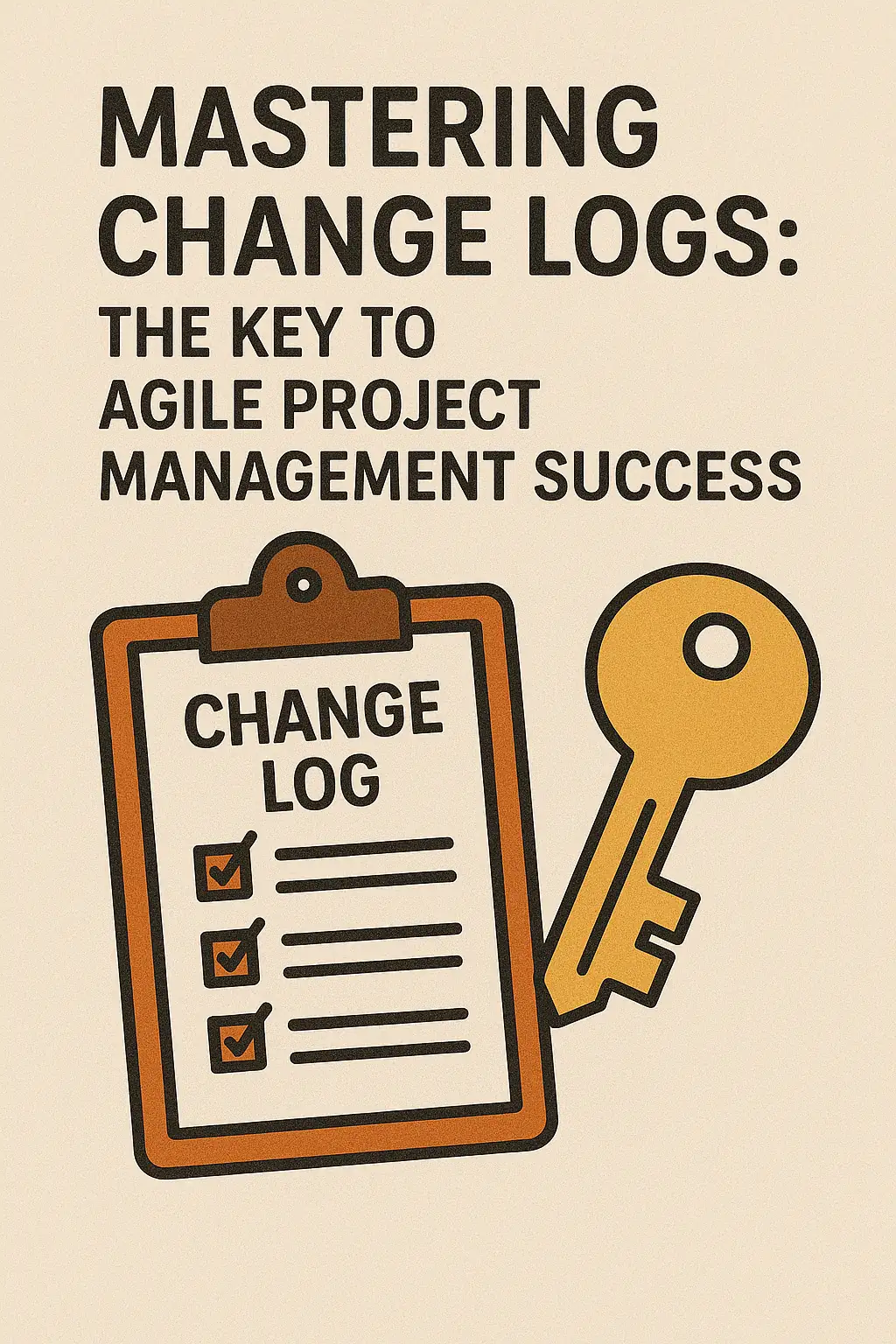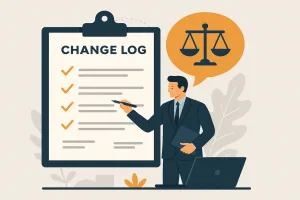Introduction to Change Logs in Agile Project Management
The ability to adapt and respond to change is paramount. One of the essential tools that facilitate this adaptability is the change log. A change log is a documented record that systematically captures all notable changes made to a project, including updates, bug fixes, and improvements. This chronological record serves multiple purposes, primarily aimed at enhancing transparency and communication among team members and stakeholders [2][11].
The Role of Change Logs in Agile Methodologies
Change logs play a critical role in agile methodologies by providing a structured approach to managing changes. Agile project management emphasizes flexibility and responsiveness, and change logs support these principles by:
- Documenting Changes: They chronicle the evolution of a project, allowing teams to track what has been modified, added, or removed over time. This documentation is vital for understanding the project’s trajectory and ensuring that all team members are aligned with the latest developments [10][11].
- Facilitating Communication: By maintaining a clear record of changes, teams can communicate effectively with stakeholders, ensuring everyone is informed about the current state of the project. This transparency fosters trust and confidence among team members and stakeholders alike [10].
- Supporting Decision-Making: Change logs provide valuable insights that can inform future decisions. By reviewing past changes, teams can identify patterns, assess the impact of modifications, and make more informed choices moving forward [10][14].
Benefits of Maintaining a Change Log
The advantages of maintaining a change log in agile project management are manifold:
- Enhanced Transparency: Change logs offer stakeholders a detailed view of the product’s development journey, which is crucial for building trust and confidence in the project [10].
- Improved Accountability: By documenting changes, teams can hold themselves accountable for the decisions made throughout the project lifecycle. This accountability is essential for continuous improvement and learning [10].
- Streamlined Collaboration: A well-maintained change log serves as a reference point for all team members, reducing confusion and ensuring that everyone is on the same page regarding project updates [11][13].
- Efficient Tracking of Progress: Change logs help teams monitor their progress against project goals, making it easier to identify areas that require attention or adjustment [10][12].
The Importance of Change Logs for Agile Teams
Change logs serve as a crucial tool that can significantly enhance the effectiveness and efficiency of project teams. Here are several key reasons why maintaining comprehensive change logs is vital for Agile teams:
- Enhancing Transparency and Communication: Change logs foster a culture of transparency within Agile teams. By documenting changes, updates, and decisions made throughout the project lifecycle, all team members can stay informed about the project’s current state. This transparency not only improves communication but also builds trust among team members, as everyone is aware of the project’s progress and any modifications that have occurred [1].
- Tracking Project Evolution and Understanding Decisions Made: Change logs provide a historical record of the project’s evolution. They allow teams to track what changes were made, when they were implemented, and the rationale behind those decisions. This documentation is invaluable for understanding the trajectory of the project and can help in identifying patterns or recurring issues that may need to be addressed. By having a clear view of past changes, teams can make more informed decisions moving forward [2].
- Facilitating Better Retrospectives and Lessons Learned: Agile methodologies emphasize continuous improvement, and change logs play a pivotal role in this process. During retrospectives, teams can refer to change logs to review what changes were made and assess their impact on the project. This reflection helps teams to identify what worked well and what didn’t, enabling them to learn from their experiences and apply those lessons to future sprints. By systematically analyzing changes, teams can enhance their processes and outcomes over time [3].
Key Components of an Effective Change Log
Maintaining a well-structured change log is crucial for ensuring transparency, accountability, and adaptability. An effective change log not only documents changes but also serves as a communication tool that enhances the agility of project teams. Here are the essential elements that make up a successful change log:
- Date of Change: This component records when the change was made. Keeping a precise timeline of changes is vital for tracking the evolution of the project and understanding the context of decisions made over time. It allows teams to reference specific changes during retrospectives or reviews, ensuring that all members are aligned on the project’s history and progress.
- Description of Change: This section details what was altered and the rationale behind the change. A clear and concise description helps all stakeholders understand the nature of the change, whether it involves new features, modifications to existing functionalities, or adjustments in project scope. This clarity is essential for maintaining focus and ensuring that everyone is on the same page regarding project objectives.
- Impact Assessment: Evaluating how the change affects the project is a critical aspect of the change log. This assessment should include potential impacts on timelines, budgets, and overall project goals. By understanding the implications of each change, teams can make informed decisions and prioritize tasks effectively, ensuring that the project remains on track and aligned with stakeholder expectations.
- Stakeholders Involved: Identifying who was affected or responsible for the change is important for accountability and communication. This component ensures that all relevant parties are informed about the changes and can provide input or feedback as necessary. It fosters collaboration and helps in managing relationships with stakeholders, which is vital for the success of Agile projects.
Incorporating these key components into a change log not only enhances the agility of project management but also promotes a culture of transparency and continuous improvement within teams. By mastering change logs, Agile project managers can navigate the complexities of project changes more effectively, leading to greater project success and stakeholder satisfaction.
Best Practices for Maintaining Change Logs
Effective change logs are essential for enhancing agility in project management, particularly within Agile frameworks. They serve as a vital tool for tracking modifications, ensuring transparency, and facilitating communication among team members. Here are some actionable strategies for keeping change logs up-to-date and useful:
- Establish a Routine for Updating Change Logs: Regular updates to change logs are crucial for maintaining their relevance. Set a specific cadence for reviewing and updating logs, such as at the end of each sprint or during regular team meetings. This practice ensures that all changes are documented promptly and reduces the risk of overlooking important modifications [11].
- Involve Team Members in Documenting Changes: Encourage all team members to participate in the documentation process. By involving the entire team, you can capture diverse perspectives and insights regarding changes. This collaborative approach not only enhances the accuracy of the logs but also fosters a sense of ownership among team members, making them more likely to keep the logs updated [14].
- Utilize Collaborative Tools for Real-Time Updates: Leverage collaborative project management tools that allow for real-time updates to change logs. Tools like Azure Boards or other Agile project management software can facilitate immediate documentation of changes as they occur. This ensures that everyone has access to the most current information, promoting transparency and effective communication within the team [8][9].
- Keep Logs Concise and Clear to Ensure Readability: Clarity and brevity are key when maintaining change logs. Avoid overly technical jargon and ensure that each entry is straightforward and easy to understand. This practice not only aids in quick reference but also ensures that all stakeholders, regardless of their technical background, can comprehend the changes being documented [11][12].
By implementing these best practices, Agile project managers and teams can enhance their change management processes, leading to improved project outcomes and greater adaptability in the face of evolving project requirements.
Integrating Change Logs into Your Agile Workflow
In the fast-paced world of Agile project management, maintaining clarity and adaptability is crucial. One effective tool that can significantly enhance agility is the change log. By systematically documenting changes, teams can ensure that everyone is aligned and informed, ultimately leading to more successful project outcomes. Here’s how to seamlessly incorporate change logs into your existing Agile processes.
Identify Key Moments for Logging Changes
To maximize the effectiveness of change logs, it’s essential to pinpoint the key moments in the Agile process where changes are most impactful. These moments typically include:
- Sprint Planning: During this phase, teams can document any changes to the scope or objectives of the sprint. This ensures that all team members are aware of what has been altered and why, fostering a shared understanding of the sprint goals [3].
- Sprint Reviews: After each sprint, teams should log any feedback received and subsequent changes to the product backlog. This practice not only helps in tracking progress but also in making informed decisions for future sprints [14].
- Retrospectives: This is a critical moment for reflection and improvement. Documenting changes that arise from retrospective discussions can help teams implement actionable insights in subsequent sprints, ensuring continuous improvement [12].
Utilize Change Logs Effectively
Integrating change logs into your Agile workflow requires a strategic approach. Here are some best practices:
- Incorporate Change Requests: By adding a change request work item type, teams can formally track and log changes. This structured approach helps in managing changes systematically and ensures that nothing is overlooked [3].
- Regular Updates: Encourage team members to update the change log regularly, especially after significant meetings or decisions. This habit keeps the log current and relevant, making it a reliable resource for the team [10].
- Visibility and Accessibility: Ensure that the change log is easily accessible to all team members. This transparency fosters a culture of accountability and encourages team members to refer to the log frequently [15].
Encourage a Culture of Documentation
Creating a culture that values documentation is vital for the successful integration of change logs. Here are some strategies to promote this culture:
- Lead by Example: Project managers and team leaders should actively use and refer to the change log. When leadership prioritizes documentation, it sets a standard for the rest of the team [6].
- Training and Workshops: Conduct training sessions to educate team members on the importance of change logs and how to use them effectively. This can help demystify the process and encourage participation [11].
- Feedback Mechanism: Establish a feedback loop where team members can suggest improvements to the change log process. This involvement not only enhances the log’s effectiveness but also empowers team members to take ownership of the documentation process [12].
By integrating change logs into your Agile workflow, you can enhance communication, improve project tracking, and foster a culture of continuous improvement. This strategic approach not only supports Agile principles but also drives project success, making change logs an indispensable tool for Agile project managers and teams.
Tools and Technologies for Effective Change Logging
Maintaining an effective change log is crucial for ensuring transparency, accountability, and adaptability. Change logs help teams track modifications, understand the impact of changes, and communicate effectively with stakeholders. Here, we explore various tools and technologies that can aid in maintaining and managing change logs, along with insights on manual versus automated logging and tips for selecting the right tool for your team.
Overview of Popular Project Management Tools with Change Log Features
Several project management tools come equipped with features that facilitate effective change logging. Some of the most popular options include:
- Jira: Designed specifically for software teams, Jira allows users to document changes in user stories and tasks, making it easier to track modifications throughout the project lifecycle. Its integration with Agile methodologies supports sprint planning and backlog refinement, which are essential for maintaining an up-to-date change log [1].
- Trello: Utilizing a card-based system, Trello enables teams to add comments and attachments to cards, which can serve as a change log. Each card can represent a task or feature, and the history of changes can be easily accessed, providing a visual representation of progress and modifications.
- Asana: Asana offers a timeline view that allows teams to visualize project changes over time. Users can log changes directly in task comments, ensuring that all modifications are documented and easily retrievable.
- Monday.com: This platform provides customizable boards where teams can track changes in real-time. The ability to add status updates and comments helps maintain a comprehensive change log that reflects the current state of the project.
Comparison of Manual vs. Automated Change Logging
When it comes to change logging, teams often face the choice between manual and automated methods:
- Manual Change Logging: This approach involves team members documenting changes in a shared document or spreadsheet. While it allows for flexibility and customization, it can be time-consuming and prone to human error. Manual logging may also lead to inconsistencies, especially in larger teams where communication can break down.
- Automated Change Logging: Automated tools streamline the change logging process by capturing changes in real-time. For instance, project management software can automatically log changes made to tasks, deadlines, and project scopes. This method enhances accuracy and saves time, allowing teams to focus on delivering value rather than administrative tasks. Automated logging also provides a clear audit trail, which is essential for accountability and compliance.
Tips for Selecting the Right Tool for Your Team’s Needs
Choosing the right tool for change logging is vital for enhancing agility in project management. Here are some tips to consider:
- Assess Team Size and Structure: Consider the size of your team and how they collaborate. Larger teams may benefit from tools that offer robust integration and communication features, while smaller teams might prefer simpler, more intuitive options.
- Evaluate Integration Capabilities: Ensure that the tool you choose can integrate seamlessly with other software your team uses, such as version control systems or communication platforms. This will help maintain a cohesive workflow and ensure that change logs are updated automatically.
- Prioritize User Experience: A user-friendly interface is essential for encouraging team adoption. Tools that are easy to navigate will reduce the learning curve and promote consistent use of change logging features.
- Look for Customization Options: Every team has unique needs, so select a tool that allows for customization of change log formats and categories. This flexibility will help your team tailor the change log to fit specific project requirements.
- Consider Reporting Features: Effective change logs should not only document changes but also provide insights into project performance. Look for tools that offer reporting capabilities to analyze the impact of changes on project timelines and deliverables.
By leveraging the right tools and technologies for change logging, Agile project managers can enhance their team’s agility, improve communication, and ensure that all modifications are tracked effectively. This proactive approach to change management is essential for navigating the complexities of modern project environments.
Real-World Examples of Change Log Implementation
The implementation of change logs has proven to be a transformative practice that enhances flexibility and responsiveness. Here are some compelling success stories from Agile teams that have effectively utilized change logs, along with the challenges they faced and the measurable improvements they achieved.
1. Spotify: Rapid Innovation through Change Logs
Spotify is renowned for its Agile culture, which emphasizes rapid innovation and adaptability. The company implemented a change log system that allowed teams to document changes in real-time, facilitating better communication and collaboration across departments.
- Challenges Faced: Initially, teams struggled with maintaining consistency in logging changes, leading to gaps in information.
- Overcoming Challenges: Spotify addressed this by standardizing the change log format and providing training sessions for team members, ensuring everyone understood the importance of thorough documentation.
- Measurable Improvements: As a result, Spotify reported a 30% increase in the speed of feature delivery, as teams could quickly reference past changes and avoid redundant work [14].
2. Walmart: Adapting to Market Changes
Walmart faced significant challenges in adapting to the rapidly evolving retail environment. Traditional project management methods were too slow, resulting in missed opportunities and declining customer satisfaction.
- Challenges Faced: The lack of a structured change log made it difficult to track adjustments and their impacts on project timelines.
- Overcoming Challenges: Walmart implemented a comprehensive change log system that integrated with their Agile project management tools, allowing for real-time updates and visibility across teams.
- Measurable Improvements: This shift led to a 25% improvement in project turnaround times and a notable increase in customer satisfaction scores, as teams could respond more swiftly to market demands [12].
3. LEGO: Embracing an Agile Mindset
LEGO’s transition to Agile required a significant cultural shift, where embracing change became a core value. The company adopted change logs to document not only project changes but also the rationale behind them.
- Challenges Faced: Employees were initially resistant to the change, viewing it as an additional burden rather than a beneficial tool.
- Overcoming Challenges: LEGO fostered an environment of open communication, encouraging teams to share their experiences with change logs and how they facilitated smoother project transitions.
- Measurable Improvements: This approach resulted in a 40% reduction in project delays, as teams became more aligned and informed about ongoing changes [8].
4. JP Morgan Chase: Streamlining Financial Projects
In the financial sector, JP Morgan Chase implemented change logs to manage complex projects that required strict compliance and oversight.
- Challenges Faced: The complexity of financial regulations made it challenging to keep track of changes and their implications.
- Overcoming Challenges: The company developed a detailed change log template that included compliance checks, ensuring that all changes were documented with regulatory considerations in mind.
- Measurable Improvements: This practice led to a 20% decrease in compliance-related issues and improved project delivery timelines, as teams could quickly assess the impact of changes on regulatory requirements [1].
Conclusion: Embracing Change Logs for Agile Success
Maintaining a change log is not just a best practice; it is a fundamental component that can significantly enhance a team’s agility and responsiveness. Here’s a recap of the benefits of maintaining a change log:
- Enhanced Tracking and Transparency: Change logs provide a comprehensive record of all modifications, updates, and revisions made throughout the project lifecycle. This transparency allows developers, project managers, and clients to understand the status of ongoing work and the impact of implemented changes, fostering better communication and collaboration among stakeholders [10][11].
- Improved Change Management: By documenting changes systematically, teams can manage the change process more effectively. A well-maintained change log helps in tracking requests, approvals, and rejections, ensuring that all stakeholders are informed and that changes are implemented accurately [12][13]. This organized approach not only facilitates effective change management but also serves as a valuable resource for future projects, enabling teams to learn from past experiences [12].
- Risk Mitigation: Change logs include critical information such as the date of changes and their potential impact on the project in terms of risk, time, and cost. This allows teams to anticipate challenges and make informed decisions, ultimately leading to more successful project outcomes [15].
To fully leverage the advantages of change logs, agile teams are encouraged to adopt best practices for change logging. This includes:
- Regular Updates: Ensure that the change log is updated consistently to reflect the most current state of the project. This practice helps maintain accuracy and relevance, making it easier for all team members to stay aligned.
- Involvement of All Stakeholders: Encourage all team members and stakeholders to contribute to the change log. This collaborative approach not only enriches the log with diverse insights but also fosters a sense of ownership and accountability among the team.
- Utilization of Tools: Consider using project management software that integrates change logging features. This can streamline the process and make it easier to track changes in real-time, enhancing overall efficiency [8].
In conclusion, embracing change logs is essential for agile project management success. By implementing effective change logging practices, teams can enhance their agility, improve communication, and ultimately drive better project outcomes. Start implementing change logs in your projects today to unlock the full potential of your agile practices and ensure that your team is well-equipped to navigate the complexities of project management.
Find out more about Shaun Stoltz https://www.shaunstoltz.com/about/.
This post was written by an AI and reviewed/edited by a human.



